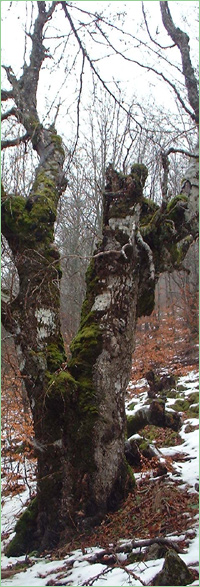Pirin (Unique identification code in the register: BG0000209)
Category: PZ under both Directives
Area: 40382.38 hectares Location:
1.
District: Blagoevgrad, Municipality: Bansko, Locality: Bansko, Dobrinishte, Kremen, Obidim
2.
District: Blagoevgrad, Municipality: Gotse Delchev, Locality: Breznitsa, Kornitsa
3.
District: Blagoevgrad, Municipality: Kresna, Locality: Stara Kresna, Vlahi
4.
District: Blagoevgrad, Municipality: Razlog, Locality: Razlog
5.
District: Blagoevgrad, Municipality: Sandanski, Locality: Gorna Sushitsa, Lilyanovo, Pirin, Ploski, Sugarevo
6.
District: Blagoevgrad, Municipality: Simitli, Locality: Brezhani, Gradevo, Senokos
7.
District: Blagoevgrad, Municipality: Strumyani, Locality: Ilindentsi
Falls in the territory of the following Regional Inspectorates of Environment and Water (RIEW):
Blagoevgrad - ul."Svoboda" № 1
Ordinance for announcement:
Ordinance No.РД-572 from 08.09.2008
2-3-209-572-2008
Ordinance for change:
1.
Change in the aims with Ordinance No.РД-284 from 31.03.2021
2.
Change in the subject for conservation with Ordinance No.РД-284 from 31.03.2021
Record for protected zone (link):

Aims of the declaration:
1. Protection and maintenance of the habitats of the bird species referred to in items 2.1 and 2.2, their populations and distribution within the zone, in order to achieve and maintain their favorable condition;
2. Conservation and maintenance of the natural habitat types referred to in point 2.3, the habitats of the species referred to in point 2.4, their populations and distribution within the zone, in order to achieve and maintain their favorable conservation status in the Alpine biogeographical regions;
3. Improving the state of the habitats of bird species Neophron percnopterus, Falco vespertinus, Crex crex and Emberizia hortulana;
4. Increase the contribution of the protected zone to the area of natural habitats with codes 4060, 6170, 62D0, 6430 and 7140;
5. Improving the structure and functions of natural habitats with codes 9110, 9130, 91D0* and 9530*;
6. If necessary, improvement of the condition or restoration of types of natural habitats refered in item 2.3, habitats of the species refered in item 2 and their populations.
Objects of protection (species or habitats):
1. Article 6, paragraph 1, section 3 from Biological Diversity Act: Great White Egret (Egretta alba), Black-crowned Night Heron (Nycticorax nycticorax), Black Stork (Ciconia nigra),White Stork (Ciconia ciconia), Egyptian Vulture (Neophron percnopterus), Griffin Vulture (Gyps fulvus), Osprey (Pandion haliaetus), Black Kite (Milvus migrans), Levant sparrowhawk (Accipiter brevipes), Honey Buzzard (Pernis apivorus), Long-legged Buzzard (Buteo rufinus), Hen Harrier (Circus cyaneus), Lesser Spotted Eagle (Aquila pomarina), Golden Eagle (Aquila chrysaetos), Booted Eagle (Hieraaetus pennatus), Short-toed Eagle(Circaetus gallicus), Peregrine Falcon (Falco peregrinus), Red-footed Falcon (Falco vespertinus), Saker Falcon(Falco cherrug), Hazel Hen (Bonasa bonasia), Western Capercaillie (Tetrao urogallus), Corncrake (Crex crex), Eurasian Eagle-owl (Bubo bubo), Eurasian Pygmy Owl (Glaucidium passerinum), Tengmalm's Owl (Aegolius funereus), Nightjar (Caprimulgus europaeus), White-backed Woodpecker (Dendrocopos leucotos), Grey-headed Woodpecker(Picus canus), Black Woodpecker (Dryocopus martius), Three-toed Woodpecker (Picoides tridactylus), Woodlark (Lullula arborea), Tawny Pipit (Anthus campestris), Red-backed Shrike (Lanius collurio), Lesser Grey Shrike (Lanius minor), Barred Warbler (Sylvia nisoria), Semi-collared flycatcher (Ficedula semitorquata), Ortolan Bunting (Emberizia hortulana), Rock Partridge (Alectoris graeca);
2. Article 6, paragraph 1, section 4 from Biological Diversity Act: Common Buzzard (Buteo buteo), Eurasian sparrowhawk (Accipiter nisus), Common Kestrel (Falco tinnunculus), Eurasian Hobby (Falco subbuteo), Little Ringed Plover (Charadrius dubius), Common Sandpiper (Actitis hypoleucos), European Bee-eater (Merops apiaster).
3. Article 6, paragraph 1, section 1 from Biological Diversity Act: 3130 Oligotrophic to mesotrophic standing waters with vegetation of the Littorelletea uniflorae and/or Isoeto-Nanojuncetea;
3160 Natural dystrophic lakes and ponds;
3260 Water courses of plain to montane levels with the Ranunculion fluitantis and Callitricho-Batrachion;
4060 Alpine and Boreal heaths;
4070 * Bushes with Pinus mugo;
6150 Siliceous alpine and boreal grasslands;
6170 Alpine and subalpine calcareous grasslands;
6230 * Species-rich Nardus grasslands, on siliceous substrates in mountain areas;
62D0 Oro-Moesian acidophilous grasslands;
6430 Hydrophilous tall herb fringe communities of plains and of the montane to alpine levels;
6520 Mountain hay meadows;
7140 Transition mires and quaking bogs;
8110 Siliceous scree of the montane to snow levels;
8120 Calcareous and calcshist screes of the montane to alpine levels;
8210 Calcareous rocky slopes with chasmophytic vegetation;
8220 Siliceous rocky slopes with chasmophytic vegetation;
8310 Caves not open to the public;
9110 Luzulo-Fagetum beech forests;
9130 Asperulo-Fagetum beech forests;
91BA Moesian silver fir forests;
91CA Rhodopide and Balkan Range Scots pine forests;
91D0 * Bog woodland;
9410 Acidophilous Picea forests of the montane to alpine levels (Vaccinio-Piceetea);
9530 * (Sub-) Mediterranean pine forests with endemic black pines;
95A0 High oro-Mediterranean pine forests;
4. Article 6, paragraph 1, section 2 from Biological Diversity Act: Mammals - Ursus arctos, Canis lupus, Rupicapra rupicapra balcanica, Rhinolophus ferrumequinum, Rhinolophus hipposideros, Myotis myotis, Myotis emarginatus, Myotis blythii, Myotis bechsteinii, Barbastella barbastellus;
Amphibians and reptiles - Triturus karelinii, Bombina variegata, Testudo graeca, Testudo hermanni;
Fish - Leuciscus Telestes souffia;
Intervertebrates - Austropotamobius torrentium, Cordulegaster heros, Paracaloptenus caloptenoides, Morimus funereus, Rosalia alpina, Euplagia Callimorpha quadripunctaria, Polyommatus eroides, Euphydryas aurinia;
Plants - Tozzia carpathica, Buxbaumia viridis.
Current prohibitions and regimes:
1. It is prohibited grazing of domestic animals up to 100 m from the limits of the distribution of natural habitats with codes 3130 and 3160, as well as in the actual occupied habitats of the wild goat species (Rupicapra rupicapra balcanica), determined as a result of monitoring data , carried out by the Pirin National Park Directorate.
Overlapping (partial or full):
1.
National Park: Pirin
2.
Natural Monument: Orlite
3.
Reserve: Bayuvi Dupki - Dzhindzhiritsa
4.
Reserve: Yulen

|
|

|


 Превод на български
Превод на български